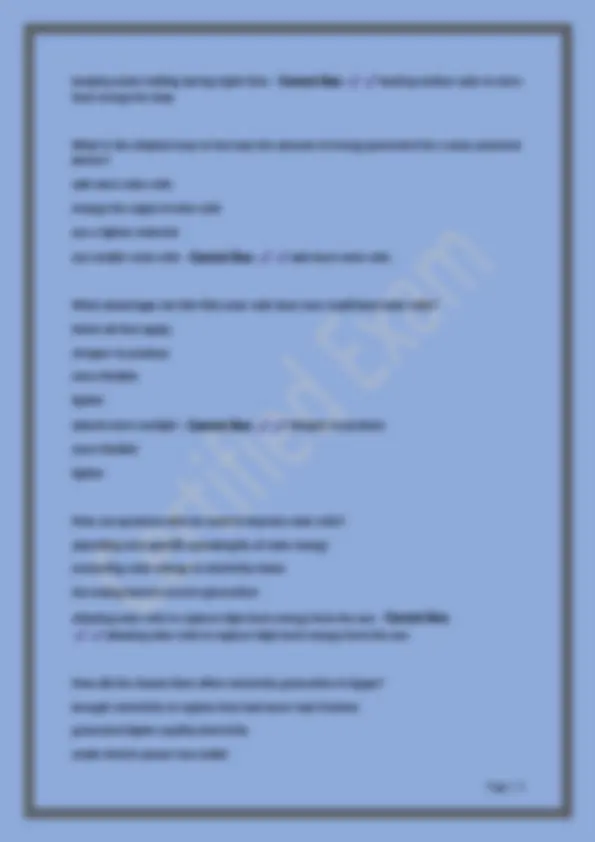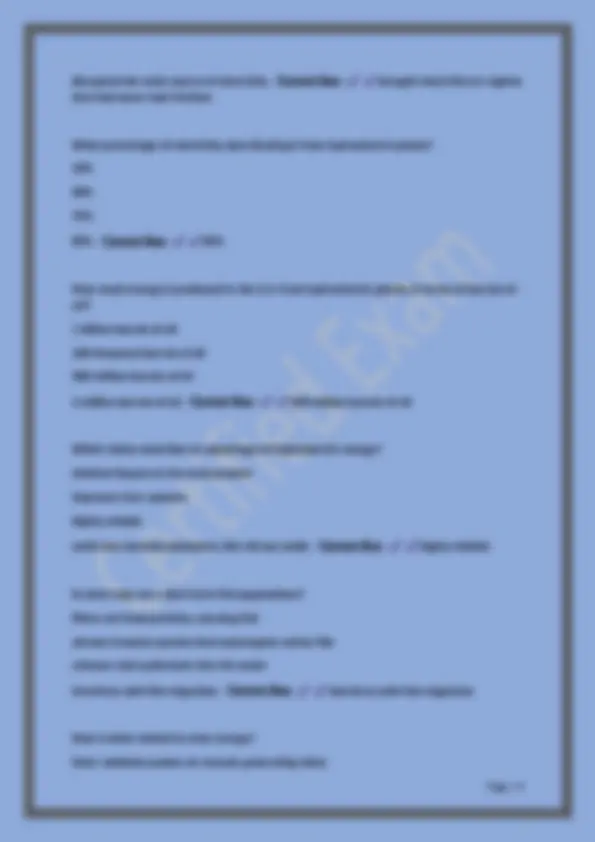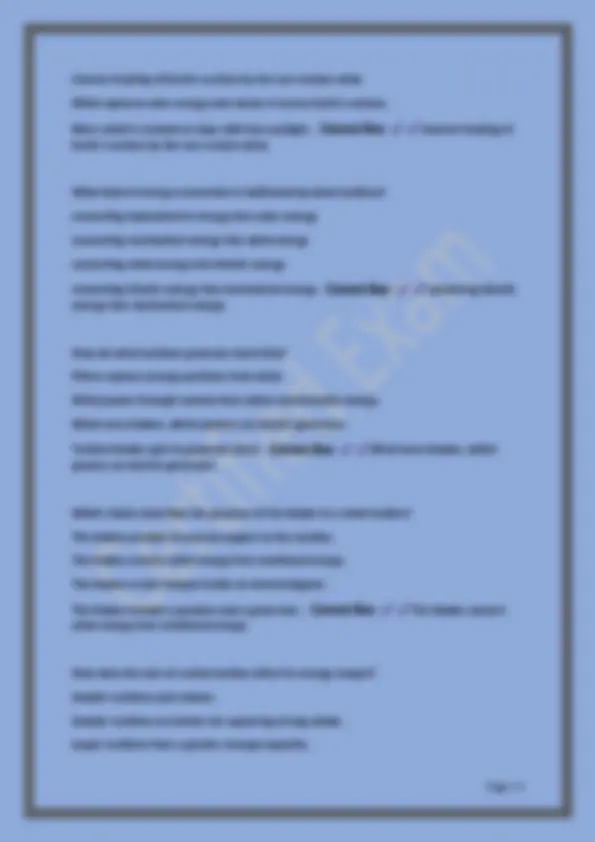





Study with the several resources on Docsity

Earn points by helping other students or get them with a premium plan


Prepare for your exams
Study with the several resources on Docsity

Earn points to download
Earn points by helping other students or get them with a premium plan
Community
Ask the community for help and clear up your study doubts
Discover the best universities in your country according to Docsity users
Free resources
Download our free guides on studying techniques, anxiety management strategies, and thesis advice from Docsity tutors
Environmental Science B Unit 3: Perpetual Resources Interim Test (Part 1)1).
Typology: Exams
1 / 7

This page cannot be seen from the preview
Don't miss anything!




What force ultimately spins a turbine to generate electricity in a concentrated solar power (CSP) system? solar radiation particles wind spinning turbine blades steam from water boiled by captured solar energy increasing temperatures causing parts in a turbine to move spontaneously - Correct Ans: steam from water boiled by captured solar energy Why was solar power not immediately popular? It was expensive. People feared solar power, because they didn't understand how it worked. No one liked how the solar panels looked. There were many other better, renewable options. - Correct Ans: It was expensive. Which choice describes a global factor that has made solar power more attractive as a source of energy? Other alternative energy sources are failing. It's becoming more expensive. Fewer people care about the environment. Fossil fuel reserves are becoming depleted. - Correct Ans: Fossil fuel reserves are becoming depleted. How do photovoltaic (PV) solar systems generate an electric current? PVsystems reflect sunlight back into space to create electricity. When a PVpanel absorbs sunlight, it triggers a chemical reaction that produces gases and electricity.
Sunlight disturbs electrons on the surface of a PVpanel. Sunlight powers thousands of microscopic generators on each panel. - Correct Ans: Sunlight disturbs electrons on the surface of a PVpanel. Why are photovoltaic ( PV ) systems ideal for remote locations? They don't need to be connected to a power grid. They produce a lot of light pollution. They require large amounts of space. They are easily damaged by nearby human activities. - Correct Ans: They don't need to be connected to a power grid. How does a dish-type concentrated solar power system collect solar energy? A half-pipe-shaped mirror concentrates light onto oil to heat it up. Panels absorb sunlight and create electric currents between them. Mirrors collect light onto a single point on a tower. A large, curved plate directs sunlight onto fluid to heat it and push a piston. - Correct Ans: A large, curved plate directs sunlight onto fluid to heat it and push a piston. How does a power tower-type concentrated solar power system collect solar energy? Flat, narrow mirrors direct light at multiple angles. A pillar covered in mirrors directs sunlight onto a central spot. Curved panels absorb sunlight. Many cylindrical mirrors concentrate light. - Correct Ans: A pillar covered in mirrors directs sunlight onto a central spot. What is one way concentrated solar power systems are trying to store power during times without sunlight? using different materials in solar panels that absorb more sunlight heating molten salts to store heat energy for days maintaining an electric current in a constant loop
disrupted the main source of electricity - Correct Ans: brought electricity to regions that had never had it before What percentage of electricity does Brazil get from hydroelectric plants? 10% 40% 75% 85% - Correct Ans: 85% How much energy is produced in the U.S. from hydroelectric plants, in terms of barrels of oil? 1 billion barrels of oil 100 thousand barrels of oil 500 million barrels of oil 2 million barrels of oil - Correct Ans: 500 million barrels of oil Which choice describes an advantage of hydroelectric energy? minimal impact on the environment improves river systems highly reliable emits less-harmful pollutants, like nitrous oxide - Correct Ans: highly reliable In what way can a dam harm fish populations? filters out food particles, starving fish attracts invasive species that outcompete native fish releases toxic pollutants into the water interferes with fish migration - Correct Ans: interferes with fish migration How is wind related to solar energy? Solar radiation pushes air around, generating wind.
Uneven heating of Earth's surface by the sun creates wind. Wind captures solar energy and moves it across Earth's surface. More wind is created on days with less sunlight. - Correct Ans: Uneven heating of Earth's surface by the sun creates wind. What kind of energy conversion is facilitated by wind turbines? converting hydroelectric energy into solar energy converting mechanical energy into wind energy converting wind energy into kinetic energy converting kinetic energy into mechanical energy - Correct Ans: converting kinetic energy into mechanical energy How do wind turbines generate electricity? Filters capture energy particles from wind. Wind passes through tunnels that collect electrostatic energy. Wind turns blades, which powers an electric generator. Turbine blades spin to generate wind. - Correct Ans: Wind turns blades, which powers an electric generator. Which choice describes the purpose of the blades in a wind turbine? The blades provide structural support to the turbine. The blades convert wind energy into rotational energy. The blades create charges inside an electromagnet. The blades include a gearbox and a generator. - Correct Ans: The blades convert wind energy into rotational energy. How does the size of a wind turbine affect its energy output? Smaller turbines spin slower. Smaller turbines are better for capturing strong winds. Larger turbines have a greater storage capacity.